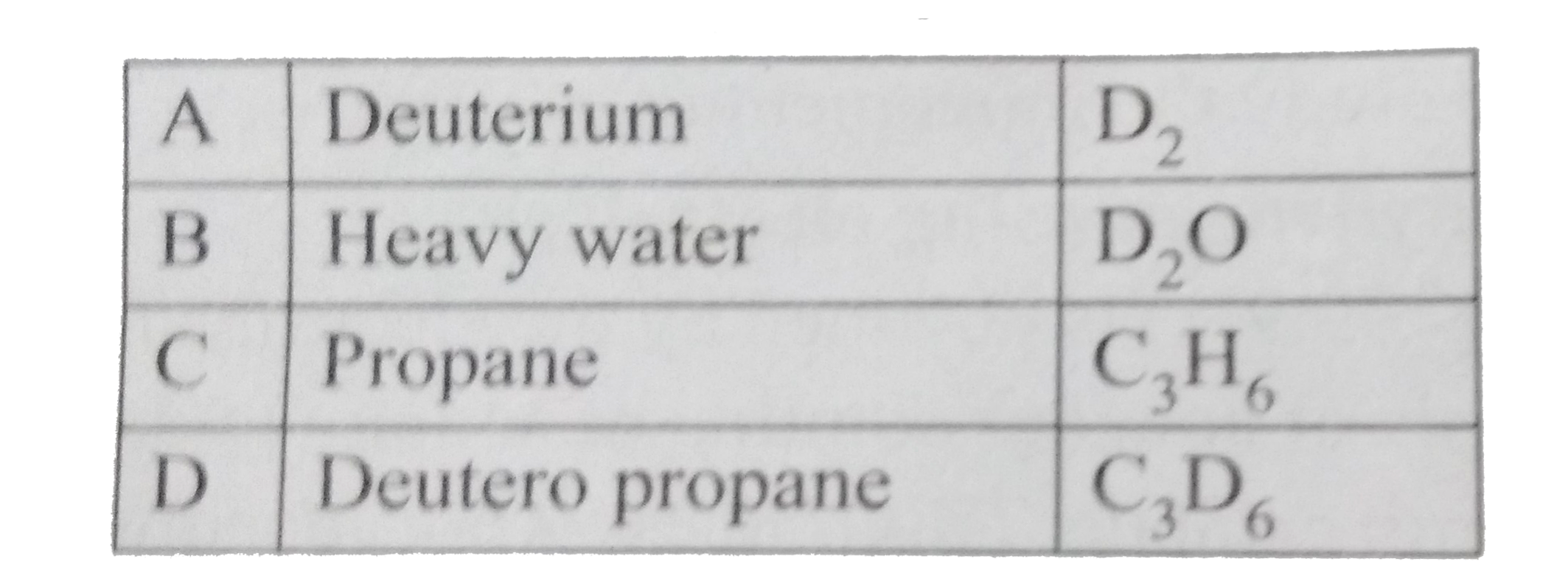An isotope of hydrogen (A) reacts with diatomic molecule of element which occupies group number 16 and period number 2 to give compound (B) is used as a modulator in nuclear reaction. (A) adds on to a compound (C), which has the molecular formula C3H6 to give (D). Identify A, B, C and D.Solution in Tamil
(i) An isotope of hydrogen Deuterium (A) reacts with diatomic molecule of element belongs to group number 16 and period number 2 oxygen O, to give a compound (B) which is heavy water D2O.D2O is used as a moderator in nuclear reaction.
2D2Deuterium(A)+O2→2D2OHeavywater(B)
(ii) Deuterium reacts with C3H6 propane (C) to give Deutero propane C6D6.(D)
3d2+C3H6→C3D6+3H2Deutero propanePropane

Topper's Solved these Questions
- BOOK - FULL MARKSCHAPTER - HYDROGEN EXERCISE - Additional Questions Solved(I. Choose the correct answer)42videos
HYDROGEN
- BOOK - FULL MARKSCHAPTER - HYDROGEN EXERCISE - Additional Questions Solved( II. Match the following)2videos
HYDROGEN
- BOOK - FULL MARKSCHAPTER - HYDROGEN EXERCISE - Additional Questions Solved 5-Mark Questions10videos
HYDROGEN
- BOOK - FULL MARKSCHAPTER - HYDROCARBONSEXERCISE - Additional Question Solved (5 mark question )15videos
HYDROCARBONS
- BOOK - FULL MARKSCHAPTER - PERIODIC CLASSIFICATION OF ELEMENTS EXERCISE - Activity 3.21videos
PERIODIC CLASSIFICATION OF ELEMENTS
Similar Questions
Which one of the following element mostly present in the sun and the stars?
03:25View SolutionMatch the List-I and List-Il using the correct code given below the list.
 04:35View Solution
04:35View SolutionExplain about the different industrial preparation of hydrogen.
03:09View SolutionExplain the conformation analysis of ethane
View SolutionThe electronegativity for some elements on pauline scale of different groups and periods are listed below. Plot these values against atomic number. From the pattern, explain the variation along a period and a group.
2nd group elements : Be (1.6), Mg (1.2). Ca (1.0), Sr (1.0) Ba(0.9)
17th group elements : F (4.0), CI (3.0), Br (2.8). I (2.5)
3rd Period elements : Na(0.9), Mg(1.2), AI (1.5), Si(1.8), P(2.1), S(2.5), CI(3.0)
4th period elements : K(0.8), Ca(1.0). Sc(1.3), Ti(1.5), V(1.6), Cr(16), Mn(1.5), Fe(1.8). Co(1.9), Ni(1.9). Cu(1.9). Zn(16), Ga(16), Ge(1.8), As(2.0), Se(2.4), Br(2.8)View SolutionA group-1 metal (A) which is present in common salt reacts with (B) to give compound (C) in which hydrogen is present in -1 oxidation state. (B) on reaction with a gas (C) to give universal solvent (D). The compound (D) on reacts with (A) to give (E), a strong base. Identify A,B,C,D and E Explain the reaction.
View SolutionAn element A occupies group number 17 and period number 2, is the most electronegative element. Element A reacts with another element B, which occupies group number 17 and period number 4, to give a compound C. Compound c undergoes sp^(2)d^(2) hybridisation and has octahedral structure. Identify the elements A and B and the compound C. Write the reactions.
02:56View SolutionAn element A occupies group number 15 and period number 3, reacts with chlorine to give compound B. The compounds B on hydrolysis gives a dibasic acid C. The compound C on heating undergoes auto oxidation and reduction to give a tribasic acid D. Identify the elements A, compounds B, C and D. Write the reactions.
04:37View SolutionA Compound (A) with molecular formula C,H,N on acid hydrolysis gives(B) which reacts with thionylchloride to give compound(C). Benzene reacts with compound (C) in presence of anhydrous AICI3 to give compound(C). Compound (C) on reduction with gives (D). Identify (A), (B), (C) and D. Write the equations.
01:54View SolutionAn organic compound (A) of molecular formula C_2H_6O on reaction with acidified K_2Cr_2O_7 gives (B) of molecular formula C_2H_4O which on further oxidation gives (C) of molecular formula C_2H_4O . Compound (C) reacts with (A) in the presence of conc. H_2SO_4 gives (D) of molecular formula C_4H_8O_2 . Identify A,B,C,D and explain the reaction involved.
02:15View SolutionAn isotope of hydrogen (A) reacts with diatomic molecule of element which occupies group number 16 and period number 2 to give compound (B) is used as a modulator in nuclear reaction. (A) adds on to a compound (C ), which has the molecular formula C3H6 to give (D) Identify A,B,C and D.
03:14View SolutionAn element A belongs to 14th group and occupies period number 6. A reacts with conc. HCl to give B an acid. A is used to prepare C which is used as an antiknock in automobilies. Identify the element A and the compounds B and C write the reactions
02:46View SolutionAn element A occupies group number 15 and period number 3, reacts with chlorine to give compound B. The compound Bon hydrolysis gives a dibasic acidC. The compound C on heating undergoes auto oxidation and reduction to give a tribasic acid D. Identify the element A, compound B,C and D. Write the reactions.
02:48View SolutionAn element A belongs to 14th group and occupies period number 6. A reacts with conc. HCl to give B an acid. A is used to prepare C which is used as an antiknock in automobilies. Identify the element A and the compounds B and C write the reactions
04:26View SolutionAn element A occupies group number 15 and period number 3, reacts with chlorine to give compound B. The compound Bon hydrolysis gives a dibasic acidC. The compound C on heating undergoes auto oxidation and reduction to give a tribasic acid D. Identify the element A, compound B,C and D. Write the reactions.
01:50View Solution

